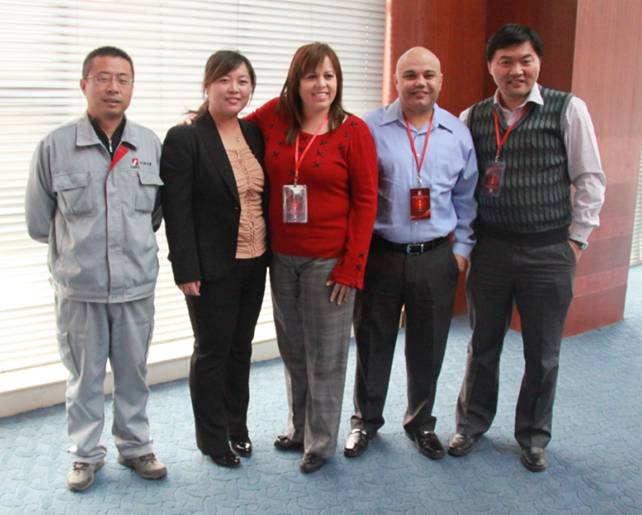Congratulations to our contract manufacturer CSPC Zhongrun Pharmaceutical (Inner Mongolia) Co., Ltd for passing the U.S. FDA inspection during October 22nd to October 26th, 2012 under the strong support from our team. For this inspection, there were two FDA inspectors, one is the top inspector and pre-approval team leader for 24 districts in United States with the professional background about pharmaceutical production and regulatory affairs, etc, and the other is a chemist with the professional background as well. In the wrap-up meeting, CSPC Zhongrun Inner Mongolia got approval recommendation as the inspection conclusion.
Welcome to visit us during CPHI-Madrid at our booth:9G61
We will participate CPHI Madrid 2012 during Oct. 09-Oct. 11 which hold in Madrid, Spain.We sincerely welcome all the friends to visit our booth and know more about PHARMAX so as to establish a long-term cooperation between us. Looking forward to seeing you at our booth: 9G61.
Welcome to visit us during HIE Frankfurt at our booth:H12-8
We will participate HIE Frankfurt during Nov. 13-Nov. 15 which hold in Frankfurt,Gemany.We sincerely welcome all the friends to visit our booth and know more about PHARMAX so as to establish a long-term cooperation between us. Looking forward to seeing you at our booth: H12-8.
Welcome to visit us during Supplyside-west 2012 at our booth:26091
We will participate Supplyside-west during Nov. 06-Nov. 08 which hold in Las vegas,USA.We sincerely welcome all the friends to visit our booth and know more about PHARMAX so as to establish a long-term cooperation between us. Looking forward to seeing you at our booth: 26091.
CPHI 2012
CPHI 2012 Welcome to our Booth W1D45 at CPHI & ICSE China 2012 Tradeshow in Shanghai, China.
Chemspec Europe
Chemspec Europe Welcome to our Booth D12F at Chemspec Europe 2012 in Barcelona, Spain
Being Fit in Middle Age Can Lower Risk of Disease Later in Life
Working out in middle age can result in fewer chronic diseases, including heart problems, diabetes, stroke, Alzheimer’s disease and cancer.
We all know that exercise is good for you  it keeps the heart healthy, works out the muscles and prepares you to take the stairs at work without fainting from exhaustion. But does all that activity actually prevent you from getting sick?
According to a study published online by the Archives of Internal Medicine, the answer is yes. Researchers say that people who are more fit when they are middle-aged have a lower rate of chronic diseases, including heart problems, diabetes, stroke, kidney disease, obstructive pulmonary conditions, lung cancer, colon cancer and Alzheimer’s disease.
Previous studies have shown that people who are more physically fit have a lower risk of dying early than those who aren’t as in shape, but the current analysis, led by Dr. Jarrett Berry of the University of Texas Southwestern Medical Center, is the first to expose a connection with chronic diseases. Berry and his colleagues compared data on fitness levels of 18,670 healthy men and women in their 40s and 50s to Medicare claims for chronic disease treatments a couple of decades later, when the participants became eligible for coverage after age 65. Each of the volunteers performed a treadmill test, during which the researchers measured the length of time they exercised to exhaustion as an indicator of their fitness. For every one-unit improvement in fitness, measured as metabolic equivalents, the volunteers enjoyed a 20% drop in the incidence of the eight conditions the scientists tracked.
MORE: Fit Vs. Fat : Which Matters More for Longevity?
Even more encouraging, says Berry, is the fact that those with the highest fitness levels battled fewer chronic conditions in the last five years of life, meaning they spent more of this time healthy rather than burdened by disease. “The results show that fitness can not only delay morbidity but prevent it,†says Berry.
So how do you get fit? It’s partly genetic, he says, but exercise can help. About half of a person’s fitness is determined by the cumulative effect of lifetime exercise, which is why physical activity during mid-life can have such long-lasting effects on health. So jogging, swimming, taking daily walks or being more physically active in general can pay off by making you healthier in your waning years.
Foods to Fight Fatigue
The right foods and nutrition can supply the oomph you’re missing.
Tired. Drained. Pooped. No matter how you put it, you’re beat and need to drum up some energy. You are not alone. Many people have trouble getting in gear in the morning, experience the afternoon slump, or just want to crash on the couch in the evening.
The exhaustion can be a constant problem for some folks. According to the CDC, 2.2 million Americans experience marked fatigue lasting at least six months.
Sluggishness can be caused by many factors, but experts say poor nutrition is a big culprit. A well-balanced diet, on the other hand, can boost energy.
“Food is truly our body’s fuel,” says Cindy Moore, MSRD, director of nutrition therapy for The Cleveland Clinic. “What we choose as our fuel is going to absolutely impact the performance of our bodies.”
How do we fill up our personal tanks, and how well do they make our engine run? The experts weigh in on how major food and drink sources and habits affect energy levels.
The Forgotten Meal
At the beginning of the day, most people dash off to work or school without a thought to their body’s dietary needs. Who has time to eat in the morning anyway?
“Breakfast is an easy meal to forget,” says Mary Ellen Camire, PhD, professor of food science and human nutrition at the University of Maine. “But if people are skipping breakfast and find they’re tired by midmorning, then it’s time to re-evaluate that eating habit.”
Research shows breakfast improves alertness and concentration, helps shed pounds by preventing overeating during the day, and prevents obesity, diabetes, and heart disease.
To get these benefits and to prepare the body for the day, the American Dietetic Association recommends carbohydrates for energy and protein for endurance. Some quick options include:
- Whole grain bagel with cheese
- Cereal with fruit and yogurt
- Whole-grain toast with peanut butter and fruit
- Hard-boiled egg sliced into a whole-wheat pita
- Scrambled eggs, toast, and fruit
- Oatmeal with raisins
For the really busy bee, Camire says choices include breakfast bars, frozen omelets and breakfast sandwiches, oatmeal packets to go, and whole-grain cereals in prepackaged plastic bowls. Be mindful, though, of the sugar and fat content of your morning meal. A study in the November 2003 issue of Pediatrics found children who ate sugary breakfasts were hungrier and ate more at lunch.
Complex Carbohydrate Charge
Healthy eating doesn’t stop in the morning. A well-balanced diet throughout the day is an essential source of sustained energy. The American Medical Association recommends that 50% to 60% of overall food intake come from carbohydrates, 30% from fat, and the rest from protein.
Although carbohydrates have gotten a bad reputation, the nutrient is still the body’s preferred source of energy, says Dave Grotto, RD, director of nutrition at the Block Center for Integrative Cancer Care in Evanston, Ill. Low-carb diets, he says, initially boost energy, but deplete it in the long run.
The best way to maximize the body’s potential for energy is to eat a combination of complex and simple carbohydrates. Complex carbohydrates, which are slow burning, should represent the bulk of the carbohydrates we eat, says Grotto. Foods such as whole grains and starchy vegetables such as potatoes, squash, pumpkin, and carrots fall into this category.
This does not mean ignoring simple carbohydrates with a slower burn, such as the sugar fructose, found in fruits, vegetables, and honey. They can provide an immediate source of energy.
Simple sugars found in candy bars, soft drinks, and cookies can also provide a quick boost, but then a big letdown afterward.
“You are going to get a rise in energy from the original hit of the sugar, but then, particularly for diabetics, sugar can drop below the baseline where it started,” says John W. Finley, associate editor of the Journal of Agriculture and Food Chemistry, a publication of the American Chemical Society. He says the peak effect of sugar normally lasts 30 minutes to an hour, depending on the dose. Anything beyond that is reportedly psychological.
Without the complex carbohydrates to sustain the blood sugars, the body loses steam. “A diet that is based in complex carbohydrates seems to have less of that peak and valley of blood sugar effect,” says Grotto.
It is also important to make sure your complex carbohydrates have fiber, says Dee Sandquist, MSRD, a spokesperson for the American Dietetic Association. “Fiber helps the carbohydrates that we eat to be more slowly absorbed by the body,” she says. “So, therefore, the body gets a more balanced release of energy, as opposed to the quick burst of energy.”
Many processed carbohydrates such as white rice, white bread, and pasta contain little or no fiber, thus expending energy at a rapid rate. To ensure you have a food rich in fiber, check the label. A slice of bread should contain 2 to 3 grams of fiber.
Fat Force
Fat has also gotten a bad reputation, and for good reason. Too much of the “bad” fats is associated with heart disease, some types of cancer, and some chronic illnesses. In the right amount, however, fat can make food taste good, and is a concentrated source of energy.
In order to strike the right balance, choose polyunsaturated fats such as vegetable oils and seafood, and monounsaturated fats such as olive oil, meat, and poultry. The unsaturated variety can help lower “bad” LDL cholesterol.
Protein Power
Fats and carbohydrates may supply the body with energy, but protein helps regulate the release of that power. Protein maintains cells, transports hormones and vitamins, and creates muscle. Muscles and many hormones are, in fact, made up of protein. So replenishing the body’s source of the nutrient is very important.
Good sources of protein include meat, poultry, fish, eggs, beans, nuts, and low-fat dairy products.
In diets where the body does not get its usual fuel of carbohydrates and fat, protein provides the body with energy. Preliminary studies have shown that people with high-protein diets appear to be able to work longer and harder, says Finley.
Such findings, however, are controversial. Critics say high-protein diets will ultimately make people more tired and gain weight. There are also concerns the diets may increase the risk of kidney stones and osteoporosis, and be harmful to those with liver or kidney disease.
The Weight of Water
Two-thirds of the human body is made up of water. Without it, we could only live a few days. The fluid helps control body temperature through sweat, moves food through the intestines, and greases the joints. It is also an essential ingredient in the production of energy molecules.
“Dehydration is one of the leading causes of a lack of energy,” says Grotto. If you’re not well hydrated, your body puts its resources into maintaining your water balance instead of into giving you energy.
Everyone’s water needs vary. In February 2004, the Institute of Medicine released a report indicating most people meet their daily hydration needs by using thirst as their guide. In general, the Institute’s expert panel recommended that women get about 11 cups of water from food and drink each day, and men get about 16 cups daily. This may seem like a lot of liquid, but 80% of it usually comes from drinking water and other beverages. The other 20% comes from food.
To adequately get your hydration needs, particularly on a hot and humid day, the American Dietetic Association suggests carrying around a bottle of water, or replacing your afternoon soft drink with water. Frozen juice bars or icy treats are also a good idea.
Water is especially important after exercise, with certain medicines, and with a high-fiber diet. Your fluid intake should be adjusted to how much water you’re losing, says Finley. “Simple things like stopping at a drinking fountain when you walk by one is a good idea.”
Caffeine Fix
More than half of Americans reach for a coffee cup every day, and 25% drink it occasionally, reports the National Coffee Association. This should come as no surprise, as there are those who swear they cannot function without the caffeine.
The compound can be found not only in coffee, but in tea, soft drinks, chocolate, and herbs as well.
John Allred, PhD, a food science communicator for the Institute of Food Technologists, says stimulants like caffeine exaggerate the effect of natural hormones like adrenaline. “They get your heart pumping faster, you respire faster, and that gives you a stimulated feeling,” he says, noting the results usually last no more than two hours.
Psychology tests have shown a combination of caffeine and sugar can improve alertness and performance. “But then it wears off, and then you get a little bit of a slump afterward,” says Camire. The high-low effect of caffeine, she says, is not as pronounced as it is in sugar, but is significant enough in that frequent users often experience headaches without the substance.
The chemical is, indeed, so potent a stimulant that the National Collegiate Athletic Association (NCAA) lists caffeine as one of its banned drugs, as long as the concentration in a urine sample exceeds 15 micrograms per milliliter. (Two cups of black coffee will produce urine levels of approximately 3 to 5 micrograms per milliliter, according to the National Center for Drug Free Sport.)
The effect of caffeine varies from person to person. Some people need a few cups before experiencing stimulation, while others feel shaky or jittery with one serving.
Caffeine can also interfere with sleep, particularly if it is consumed in the late afternoon. The lack of shuteye could obviously affect one’s energy level. To resolve this issue, Camire recommends switching to decaffeinated beverages by about 3 p.m. She also suggests gradually cutting back on caffeinated drinks, especially since they may have a dehydrating effect.
Beating the Doldrums
Food can, indeed, raise or diminish the body’s energy levels. If you are eating healthy and are still tired, try changing the frequency of your meals. Some people find they get more of a boost with several small meals throughout the day, while others prefer the dining concept of three square meals daily. There’s no right or wrong way, says Sandquist, noting that everyone’s energy needs differ.
The amount of food you eat can also make a difference. If someone overeats constantly, they tend to gain more weight and become lethargic, says Finley. “It’s like the snowball rolling down the hill,” he explains. “As [overeaters] get more overweight, they have less energy, and then they exercise less and don’t burn the calories.”
Other dietary reasons for fatigue include too much alcohol (which is a depressant) and lack of certain vitamins and minerals. Low iron is a common problem for women.
If you still find yourself sluggish with a well-balanced diet, then a visit to the doctor may be in order. Certain diseases, medications, stress, and inadequate sleep and exercise can contribute to fatigue
Discover How to Detox For Your Health
There are many things that people do in order to keep their bodies in optimum working order. Many people exercise on a daily basis. Others are devoted to eating healthy diets. Then there are those that want to take some extra steps to ensure that their bodies are healthy. One way to do this is through Detoxification. Detox is a process that involves the removal of various toxins from the body.
There are different ways that people can detoxify their bodies. Some people choose to utilize all natural Detoxification methods while others opt for prepackaged detoxification systems. When considering how to detox it is important to choose a method that is best for one’s personal health.
Natural detoxification is preferred by many individuals. This form of detoxification is used by those that do not want to ingest chemicals or other substances in order to rid their bodies of impurities. Oftentimes, people that perform regular detoxification prefer to use all natural methods because it is much gentler on the body. Many of the all natural detoxification methods include the use of fruits or vegetables. One of the most popular methods of detoxification is pure lemon juice and water. There are many people that use this method to cleanse their bodies on a regular basis.
Another effective all-natural detoxification method is drinking green tea. Consuming green tea without any additives on a daily basis is said to be very effective in removing toxins from the body as well and providing the body with a high level of antioxidants. Nuts such as walnuts, flaxseeds, almonds and hemp seeds are believed to help in the detoxification of the body. Anyone wanting tips on how to detox naturally should consider these methods.
There are other methods of detoxification which involve the cleansing of different parts of the body. One very popular detoxification method is the colon cleanse. A colon cleanse is the process or removing various impurities from the intestinal tract. The colon is the area of the body where waste materials travel to be released from the body through a bowel movement. It is believed that because this area of the body contains a significant amount of fecal matter and other debris it is a breeding ground for parasites.
These parasites can make a person very ill and are thought to be the cause of a number of ailments. There are a number of detoxification kits specifically geared towards the cleansing the colon in an effort to improve health. Many of the colon cleanse products are available in pill form making it easy to begin the process of cleaning one’s colon and entire body.
Along with the above methods of detoxification, people will find that there are other ways to detox the body. There are a number of foot detoxification methods such as spa foot baths and foot detox patches. Dry brushing is another way in which people remove built up toxins from their bodies. Removing toxins through the pores is also possible by sweating through a sauna or by simply exercising. People wanting to know how to detox their bodies have a number of ways to do so.






